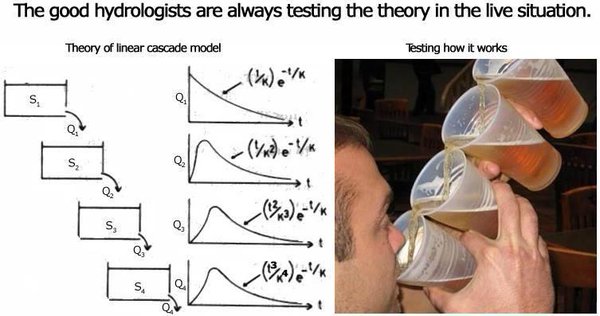Breaking news: Hydrology is the oldest of all scientific disciplines
Posted on April 1, 2017 by Dr Professor McFools
The general belief until recently has been that hydrology is a very young discipline — i. e. Homo Hydro is a quite young scientific species — but it is time to debunk this myth. Scientists from the Grand Old Duke University revealed in this issue of Environment (impact factor: highish) that they had found fossils believed to be from a previously unknown early hydrological model ancestor — one that could have used simplified functions and may have even figured out how to make certain primitive predictions without ensemble members.
Scientists believe that mysterious episodes of knowledge exchange between otherwise isolated groups of our Homo hydro (sub species modellus) ancestors may have paved the way for parameter similarity evolution. The recent discovery also suggests that outbursts of multi-objective calibration and Bayesian uncertainty post-processing, which might have (eventually) greatly enhanced model performance, might also have killed hydrologic physics and broken the links between weather prediction and water resources management.

Figure 1. Reconstruction of what is believed to be the first ever recorded hydrological model
At this point we cannot exclude the theory that the homo hydro also paired with the homo mathematicus. This combination seem to be better suited to survive in a world with growing publish-or-perish pressure, but may also be the reason why the ancient wisdom was lost for many centuries in what can been named “the great drought”. During this period, only very spurious attempts were made to explain the physical processes behind the hydrological cycle (Figure 1), and for very long only the Nilometer was thought of as the earliest sign of hydrological predictions.
Evidence that calibrated specimens of hydrological models have spread even to the most remote areas of our planet like dandelions across a lawn had already been found in a recent research carried out by the team of Prof. McFools: “My feeling is that the application-focused purposes of an ancient community on hydrologic ensemble prediction have been the substrate for the birth of real-time techniques that could only be supported by these ‘physics-killer’ types of models“, the reconstitution of which is believed to depict the prototypical hydrological model of the early years.
“It’s an excellent case of a transitional forecasting approach discovery from a critical time period in the evolution of natural hazard risk reduction“, say scientists, who are now also confident that what seems to have been called ‘the routing function’ can now be coupled to the real world of weather predictions and re-establish the long-time missing links. This should pave the way for refocusing on very applied tasks such as reservoir management.

Figure 2. Inspiration for single reservoir model and benchmark for hydropower management forecasting
Furthermore, the community realizes it must go back to fundamental laws and theoretical bases of hydrology, including a renewed commitment to rigorous and methodical development and testing.

Figure 3. How real world (right) inspires and deliver proofs of model assumptions (left)
“Our aim is to put physics back in hydrological forecasting. The fact that it has features that so clearly ally with our numerical (physically based) models helps us narrow the transition of the large-scale atmospheric and land-surface conditions, and suggests that the transition itself can be relatively approached by much simpler functions than what the current hydrological ensemble prediction community is trying to convince us that should be done” said D. McFools Jr, a graduate student member of the team that discovered the modelling remains.
“A great deal is at stake here” — he added. “I’ll be presenting my recent research findings in the next HEPEX workshop in Melbourne and I expect that the HEPEX community will praise my work and finally recognize the efforts my family has been doing for more than three years now (see here, here, and here ).”
Reference: McFools Jr, D., 2017. Has the Missing Link Been Found? International Journal of Creative Alternative Facts, 4 (17), pages 456-456.5
0 comments